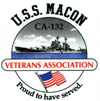 |
 |
| Main | Membership | Reunions | Officers | Store | Photos | History | Roster |
|
|
| The ship was named after a city in Bibb County in central Georgia,
named for General Nathaniel Macon, U.S. Senator from North Carolina,
December 13, 1815 to November 14, 1828, during the Era of Good Feeling. (CA -132: Displacement 13,600; Length 674'11"; Breadth. 70'10"; Draft 20'6"; Speed 33 knots.; Complement. 1,142; Armament 9 8", 12 5", 46 40mm.; Class Baltimore) Macon's HistoryMacon (CA-132) was laid down June 14, 1943 by the New York Shipbuilding Corporation, Camden, N.J.; launched October 15, 1944; sponsored by Mrs. Charles F. Bowden, wife of the mayor of Macon, Georgia; and commissioned August 26, 1945 at Philadelphia, Captain Edward E. Pare in command. Macon's first fleet assignment was with the the 8th Fleet, which she joined
soon after her shakedown cruise. Sailing with the fleet for maneuvers
in the Caribbean, she departed Norfolk on April 19, 1946, returning
to New York on May 7. On June 4, Macon arrived at Norfolk
for duty as a test ship for the operational development force. Over
the next 4 years the cruiser periodically received experimental
equipment in the Philadelphia Naval Shipyard, conducted tests of
the new equipment while she served as an antiaircraft gunnery schoolship,
and training naval reservists off the Atlantic and gulf coasts of
the United States. She also participated in a midshipmen summer
cruise to Europe in 1948. Her experimental duties continued until
April 12, 1950 when she was decommissioned and went into reserve
at Philadelphia. On the nights of January, 19 and 20, Macon steaming from Cartagena to Marseilles, diverted from her course and sped to the aid of burning Italian merchant ship Maria Amata. Macon's crew fought the flames, but the ship was soon beyond salvage. Macon then carried the merchantman's crew to Valencia, Spain. In the spring-summer of 1959, the U.S.S. Macon was the first cruiser to enter the Great Lakes region for the opening of the St. Lawrence Seaway. A photograph that was taken during it's passage through the locks was featured on the cover of Life Magazine with a cow grazing in a field in the background. This cruiser was also the first to be over 500 feet above sea level. The following January, Macon carrying the U.S. Navy Band, departed Norfolk for a good will cruise to South American Ports. While on this tour, twenty members of the band perished in a plane crash enroute to perform at a state dinner for Brazilian President J. Kubitscek, with Argentine Naval personnel participating. Macon's crew held memorial services in Buenos Aires Harbor on February 28, 1960. Completing this cruise in Rio de Janeiro in March, Macon returned to Boston to resume her cycle of operations with the Atlantic Fleet. She was placed out of commission in reserve at Philadelphia on March 10, 1961 and remained there into 1969. Naval Standard procedure is by reference to Secretary of the Navy directed that the U.S.S. Macon (CA-132) be stricken from the Naval Register on November 1, 1969 and authorized disposal in accordance with existing laws in a manner most advantageous to the government. "Historical
Ship Record File, No.3632 dated 11-1-69 CA 00132 MACON 7-5-73 to
Union Minerals and Alloys Corporation, New York City for $375,269.00
Scrapped" Macon's history is a reprint in part from: Directory of AMERICAN NAVAL FIGHTING SHIPS, NAVY DEPARTMENT, VOLUME IV, 1969, OFFICE OF CHIEF OF NAVAL OPERATIONS, NAVAL HISTORY DIVISION, WASHINGTON, DC. Editors Note: We received an email from former shipmate, Senior Chief Robert M. Henderson (ret.) correcting our listed decommissioning date, he was the last person officially attached to the Macon until he logged himself off on March 10, 1961. We thank him for his response to our site.
|
| Main | Membership | Reunions | Officers | Store | Photos | History | Roster |